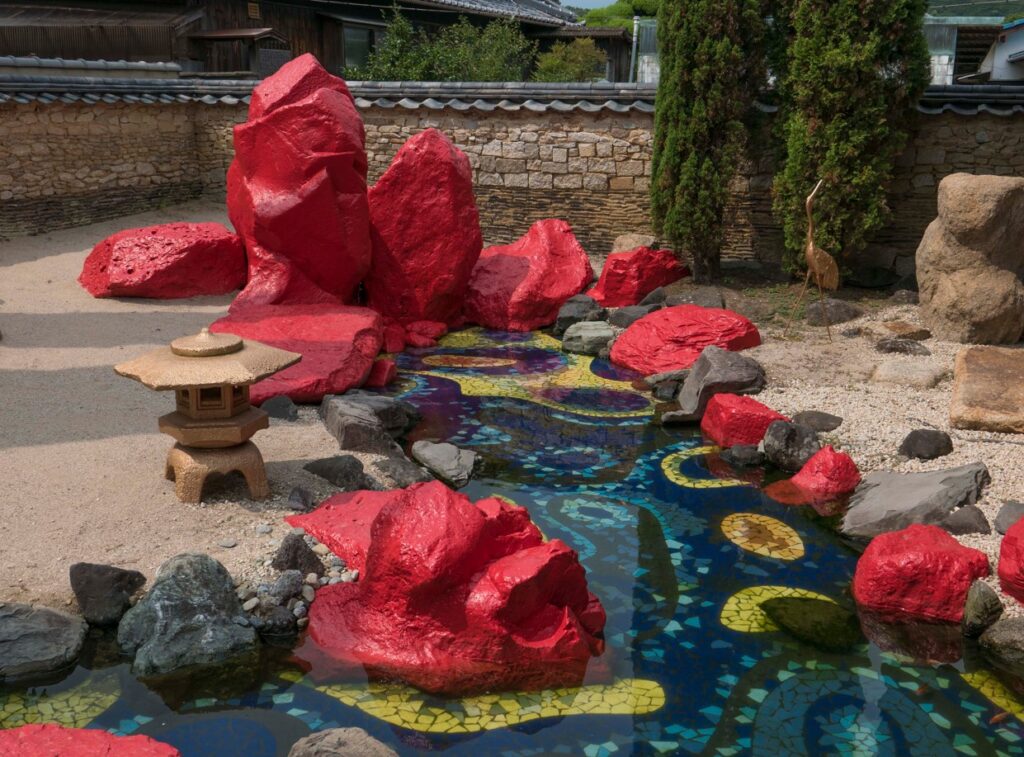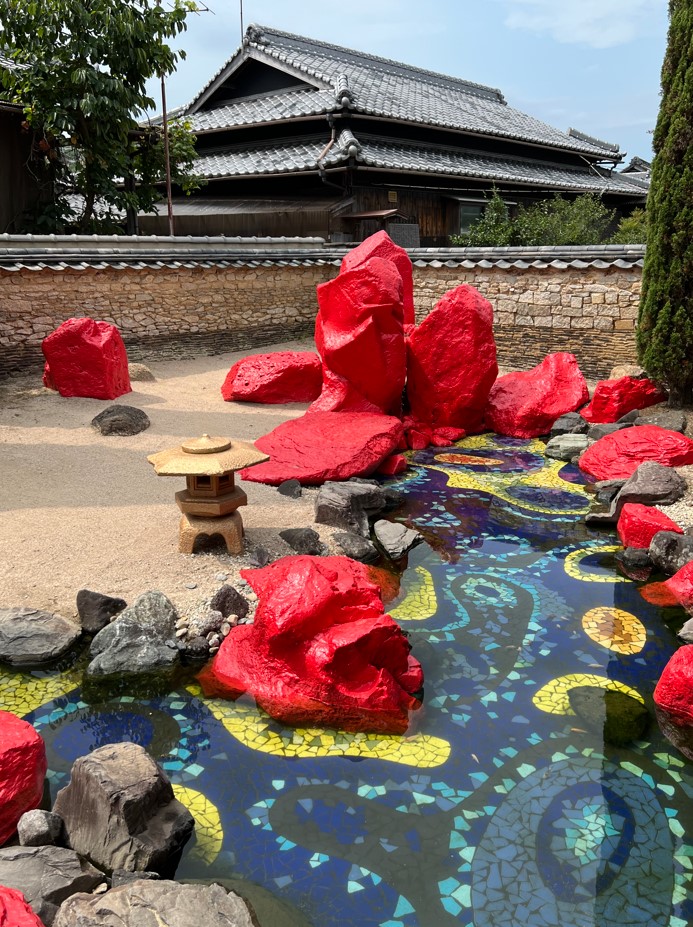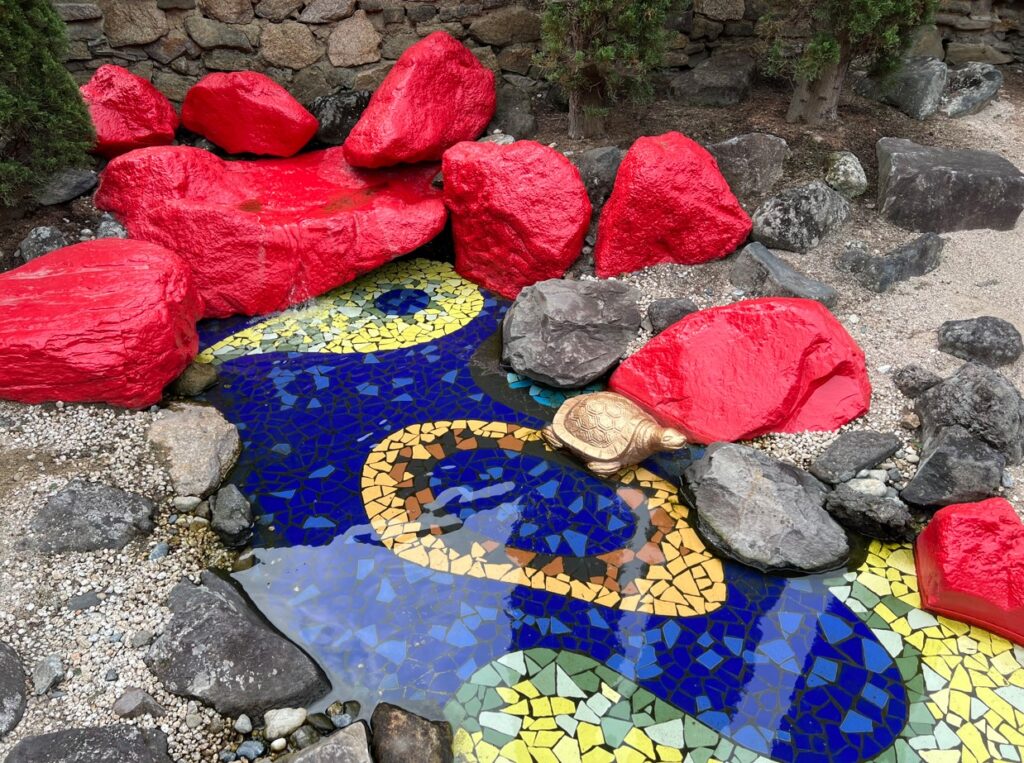Stephen Mansfield is one of the leading writers about contemporary Japan and a reviewer for The Japan Times. This modern garden profile will be included in a book he is currently writing and photographing about Japanese Gardens since 1900, due in July 2024 from British publisher Thames & Hudson.
*********************
Teshima, a tiny island in the Seto Inland Sea, would seem an improbable setting for a collaboration between international artist Yokoo Tadanori and architect Yuko Nagayama.
Active since the 1960s, Tadanori, a prolific graphic designer, printmaker, illustrator, stage set designer and figurative artist, has appropriated ideas from the expressionist, abstract and surrealist movements, forging a style that mixes pastiche and sixties psychedelia. An engagement in science fiction, spiritualism, comic art, woodblock printing, and Japanese aesthetics surface in his creations, many of which seek, through dark, satirical humor and allegory, to usurp nostalgia.
The renovated and repurposed Yokoo Tadanori House Garden opened in 2013. First reactions are predictably mixed. Some visitors will be spellbound, others repelled at its sullying of tradition. The occasional visitor will burst into hysterical laughter. No one will be indifferent, or without an opinion. This is, no doubt, a calculated effect on behalf of Tadanori, known for blurring the line in his role as artist provocateur, between innovation and hoax.

An exercise in counter-intuitive aesthetics, a number of ornamental objects, a plastic crane and turtle, and blue and yellow mosaic tiles among them, items easily picked up in the discount corners of home centers, add to the curiosity, or effrontery felt by the viewer. In creating this disturbing, but iridescent work, Tadanori has deconstructed the Japanese garden and reassembled it in his own iconoclastic, color-saturated private vision of landscape art.
Tadanori’s early pop art style follows, as writer Donald Richie put it, “a hard-edged cartoon line in bright kindergarten colors.” It is, indeed, almost as if a class of toddlers have been let loose with brushes and pots of lurid, primary paints. In this landscape Tadanori’s retro pop vocabulary, however, extends beyond paint to the materials and composition itself. Look closely at the rock dispositions, alignments and spacing, and we see that Tadanori has a surprisingly sophisticated grasp of Japanese garden design.
In common with contemporary art in general, the work poses more questions than answers. A rare instance of high kitsch in this genre, is he ridiculing the Japanese garden, as he did in canvasses depicting icons like Mount Fuji, the Rising Sun flag and kamikaze pilots, or is he revering it? Are we gazing at a toxic interpretation of the Japanese garden, or an anarchic masterpiece?
If the purpose of the garden is to unsettle us, to up-end and trick-wire expectations and assumptions, it succeeds brilliantly.



*********************
Stephen Mansfield wrote the Foreword for Donald Richie’s Travels in the East, and prominent amongst his publications are books on Japanese gardens and Tokyo history. In addition to his authored books (Amazon page), over 2,000 of his articles have appeared in publications such as The Geographical, The Middle East, South China Morning Post, CNN Travel, Japan International Journal, Japan Quarterly, The East, The Japan Journal, Japan Inc, Qantas, Wingspan, Critical Asian Studies, The Japan Times, Ikebana International.
Further Reading on the WiK Website:
In After Act, Stephen considers virus related literature in a pandemic world.
In Metropolis Stephen writes about Japanese cities.
For a review of his life in writing, given as a lunchtime talk for WiK, see here.
For a review by WiK Founder John Dougill of his book, Stone Gardens, click here.
For a short treatise on light and dark in Japanese culture, see here.
For a review by Josh Yates of Stephen’s book on Tokyo: A Biography, see here.
For Stephen Mansfield’s review of the WiK Anthology 3, Encounters with Kyoto, please click here.
